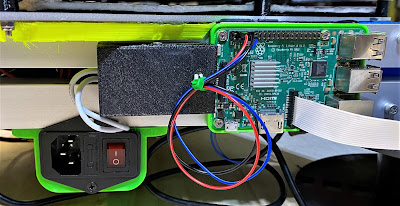 |
| Ender 3 undergoing upgrades |
Over the last year and a bit, I've been involved in beta-testing E3D's new Revo series hot-end, this is the process of upgrading my two mainline printers to run on it. One is getting my final beta hot-end, the other is getting a Revo6 I won in one of the contests E3D was running earlier this year.
.JPG) |
| Revo Micro on Voron Afterburner mount |
My Ender 3 got the beta Revo Micro, mostly since it was due for an overhaul anyway. Mount is the Voron Afterburner AB-BN variant, mostly since that was the only version that had proper support for the Revo Micro heat-sink in February, the current Stealth Burner had yet to be released at that point. Installation was fairly straightforward, I mostly followed the extruder assembly section in the Voron 2.4 manual, then it was just some calibration for the new tool-head and it was up and running.
.JPG) |
| #ShamrockE3D |
After getting it fired up, I was completely shocked by how good the print quality was, the image above is done with the 0.25mm nozzle, and aside from some light stringing, the print is basically perfect other than some ringing artifacts that are more to do with the printer frame than anything else. Incidentally, this print also won the random draw in #ShamrockE3D contest, netting a second Revo Six hot-end, so it was time to refit the Sculptor.
.JPG) |
| Revo Six on Bear Extruder |
The Sculptor had been overdue for a rebuild on its tool-head for about 6-months now, so I decided to make the conversion over to using the BearEXXA project, the same as what I'd fitted the Mendel90 with last year. Once the new printed parts where assembled, the Revo Six was a snap-in upgrade, it fits the old V6 mount design perfectly. One thing that I changed from normal assembly was adding a length of M3 rod-stock to extend the x-axis cable management tail, mainly to protect the Revo electrical quick connects, the Molex Micro-Fit 3 connectors are a known weak-point for stress failures if bent by gantry movement. The other tweak I made was installing BearEXXA Delta P v2 Fanduct, mainly due to the BearEXXA stock ducting being rather overdue for an update.
.JPG) | |
| Revo 6 with Delta-P ducting |
Once I'd gotten the updates fully dialed in, the jump in quality was frankly night and day, probably a combination of the high-performance heat-break on the Revo systems along with substantial upgrades to the part-cooling setup on both printers. And with the new high-flow and hardened nozzle-cores that have just been announced, I'm looking forward to years worth of fantastic prints out of both machines.
.JPG)





































